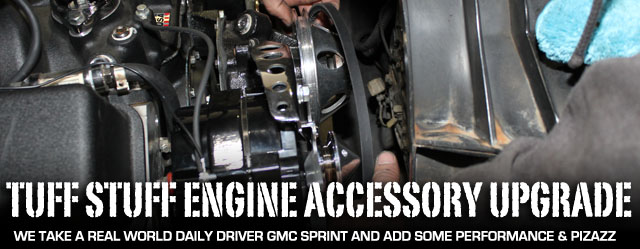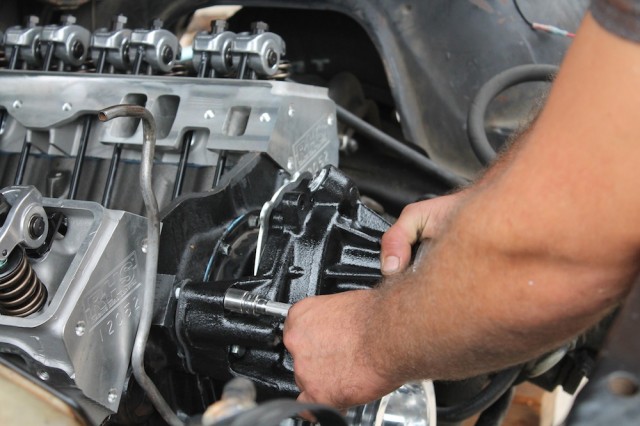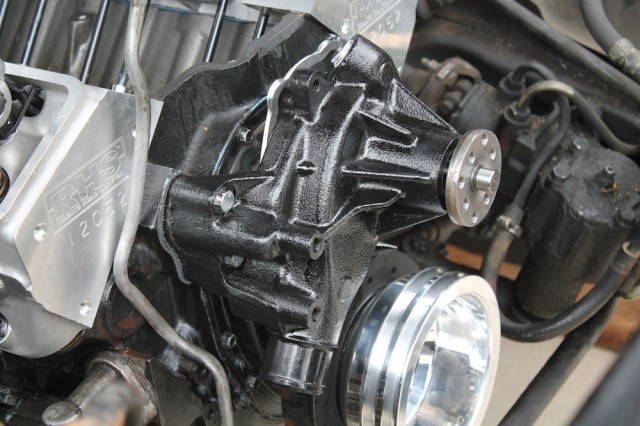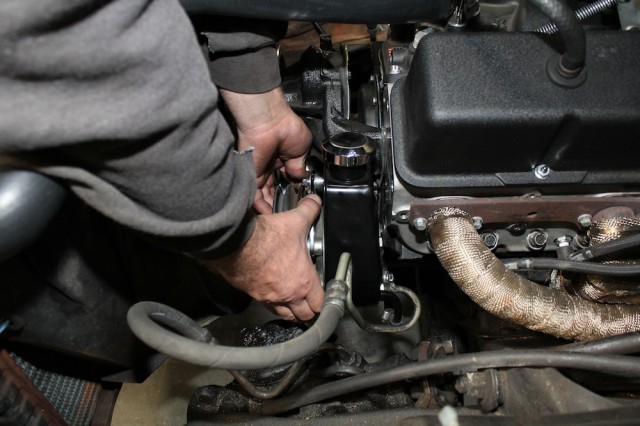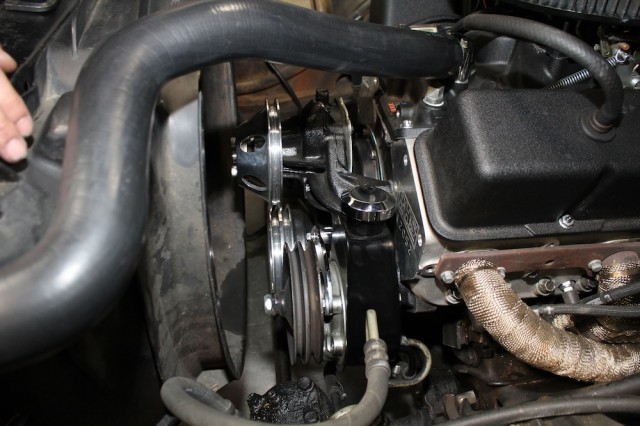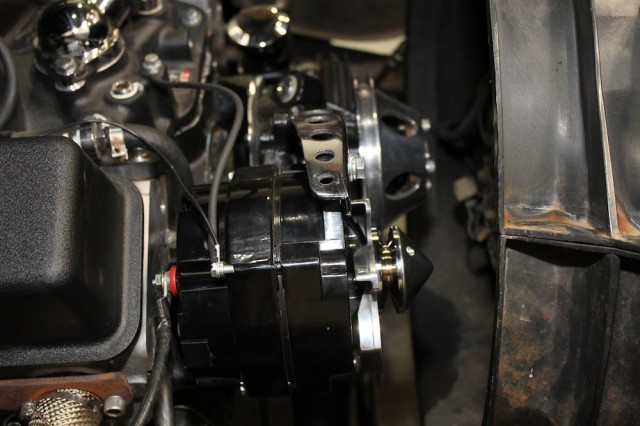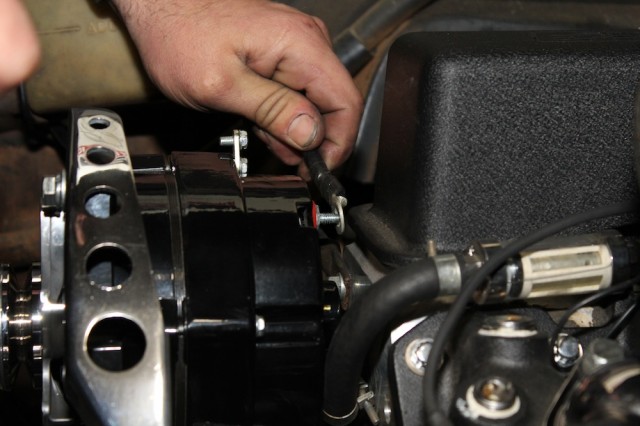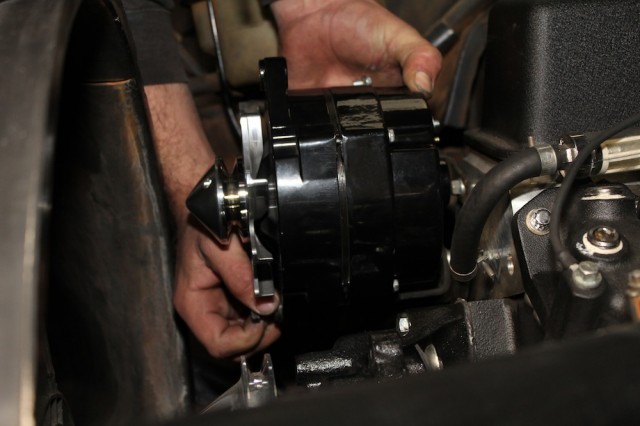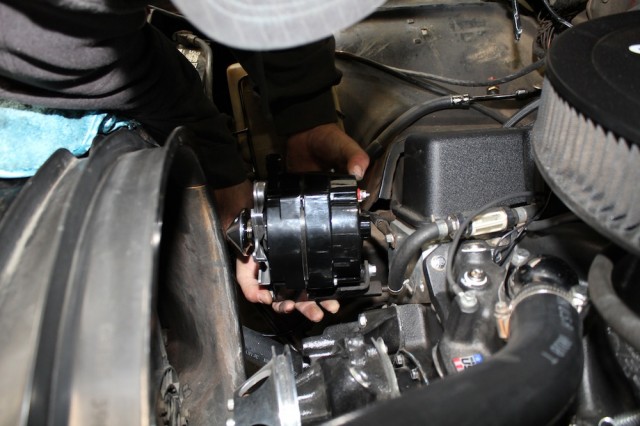The Chevrolet El Camino and GMC Sprints are not often thought of as show cars. They carry the stigma of being a working class auto, which demands a working class look, especially under the hood. This is one of those rare times when chrome isn’t the favorite color.
As luck would have it, one of our shop dawgs owns a 1972 GMC Sprint that serves as his daily driver. After performing a mild crate engine swap, we convinced him to change out the ancient OE-Style front-drive for a more reliable and work horse daily driver accessory kit from Tuff Stuff Performance Accessories [2]. Our goal was to add some performance in electrical and cooling properties while improving the appearance and belt alignment of the front-drive system in this real world daily driver.
So what does the owner of one of these utility coupe vehicles do when upgrading engine accessories without the shine? Go to the people that make some of the highest quality chrome in the industry. Seriously!
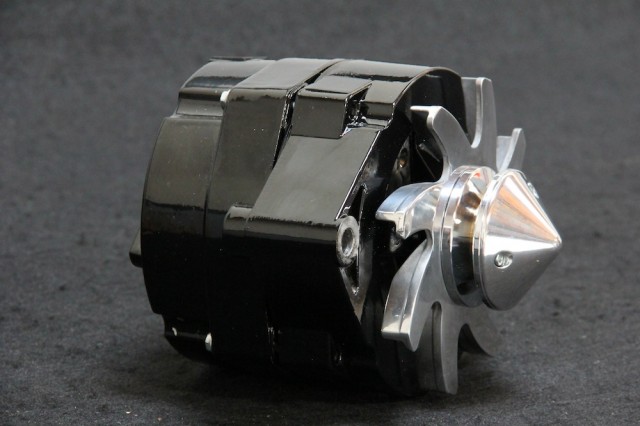 [3]
[3]Tuff Stuff chrome and powdercoated accessories are widely considered some of the highest quality on the market.
Tuff Stuff Performance Accessories [4] is well known world-wide for their chrome-plated and polished engine accessories. Performing all of their manufacturing and plating in-house has allowed them to keep a tight control of their product quality.
We custom make all these components in-house. Quality control is one of the key areas that we focus on and take pride in.
– Mike Stasko
“Our Powdercoated accessories are held to the same high standards as our chrome accessories,” says Tuff Stuff’s Mike Stasko. “The powdercoated accessories were a direct response to customer requests.”
“The powdercoating process we use results in engine accessories that have a clean look under the hood without the chrome shine, yet it has the same quality look and feel,” he adds.
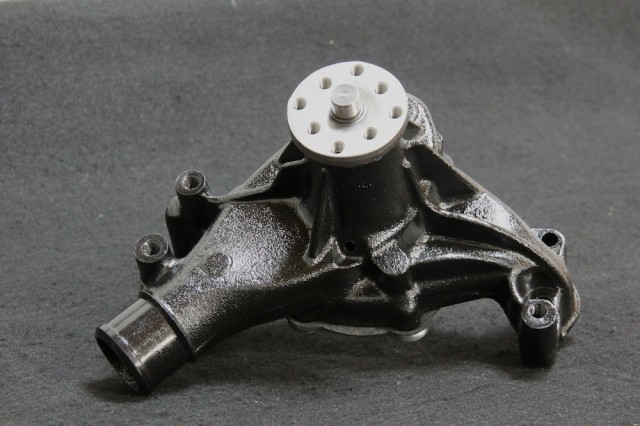 [5]
[5]Tuff Stuff’s powdercoated accessories have the same quality look and feel as their chrome counter parts.
Options
Considering any upgrade to a street engine should be done where the upgrade is designed to maximize power and the life of the vehicle’s engine. This is where Tuff Stuff really shines. “We custom make all these components in-house,” says Stasko. “Quality control is one of the key areas that we focus on and take pride in.”
The family owned and run company has done practically everything in-house. From manufacturing, sanding, polishing to chrome plating and powdercoating, it’s all done in the Tuff Stuff facilities in Cleveland, Ohio.
With this in mind, the first option is already taken care of by Tuff Stuff. Getting a true upgrade performance accessory for your pride and joy is already assured. “We hand assemble and test everything that leaves the line to assure our customers get premium parts,” states Stasko.
Alternator
Upgrading the GMC Sprint’s accessories posed a few nail biting decisions, starting with the alternator. Our ’72 GMC Sprint rolled into the shop equipped with the standard Delco 10SI alternator with internal voltage regulator and external fan for cooling. The stock-style alternator was rated with a maximum output of 63 amps. “Many vintage car owners will upgrade with our products for the higher output,” explains Stasko. That was one of the major factors in our desire to upgrade.
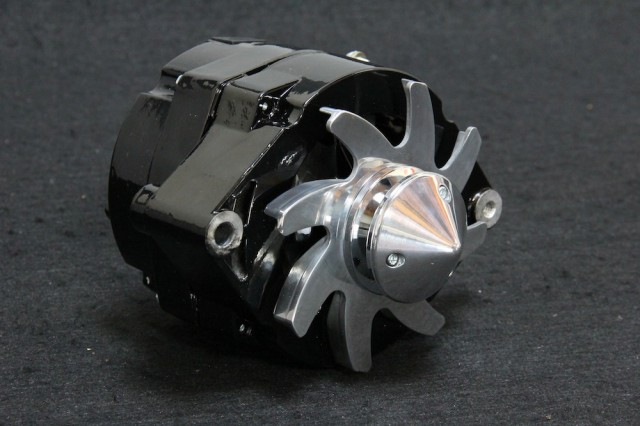 [6]
[6]Tuff Stuff’s black powdercoated one-wire, 160-amp alternator was a perfect choice for our GMC Sprint.
The most frequently asked question when considering an alternator upgrade for GM muscle is the long debated one-wire vs. OE three-wire connectors. The easiest explanation of differences between the one-wire and OE-style alternator hook up is simplicity. If you are starting a project from an empty engine bay, or if you want to minimize the amount of wires in your bay, a one-wire alternator will simplify your build. The only drawback to the one-wire alternator set-up in GM vehicles is the ALT warning lamp on your dash.
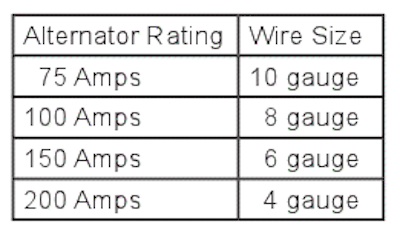 [7]Most high performance enthusiasts use a volt gauge in the cockpit and have no need for a warning light. In this case, a one-wire alternator works great. If you desire a warning light, you can get Tuff Stuff’s model 7127, 7139 or 7140 one-wire capable alternators, remove the black rubber regulator cover and plug in the existing two spade plug.
[7]Most high performance enthusiasts use a volt gauge in the cockpit and have no need for a warning light. In this case, a one-wire alternator works great. If you desire a warning light, you can get Tuff Stuff’s model 7127, 7139 or 7140 one-wire capable alternators, remove the black rubber regulator cover and plug in the existing two spade plug.
We opted to go with the black powdercoated 160-amp Tuff Stuff alternator (Part #7935CBULL). From the very generic stock 63 amp alternator to the mind blowing 160-amp upgrade is a substantial jump. One thing to keep in mind when upgrading to a higher amp alternator is that you must also upgrade the size of your charge wire. A wire that is too small can cause a fire due to the heat created by resistance.
Another concern about output rating is cooling ability. “When output rating is increased, the cooling capacity of the alternator should also be increased,” says Stasko. “We get a lot of questions about heat retention in the units because people have heard that chrome or powdercoating causes the unit to retain heat. We utilize an open air flow design so there is no heat retention in our units.”
A persistent urban legend about one-wire alternators being unable to charge a vehicle’s battery at idle is still floating around in automotive circles. “Tuff Stuff’s 30-years of experience has enabled us to develop internal components that will keep the battery charged, even at idle rpm speeds,” states Stasko. “There is no need to worry about the use of under drive pulley systems or ignition regulator turn on with the use of a Tuff Stuff one-wire alternator.”
Tuff Stuff’s alternators are available in chrome plated, polished aluminum, powdercoated and “as cast” finishes. Amp ratings range from 105 to 160 and include either a single or double V-groove pulley or a 6-groove serpentine pulley. A “Silver Bullet” aluminum pulley cover is also available on select units.
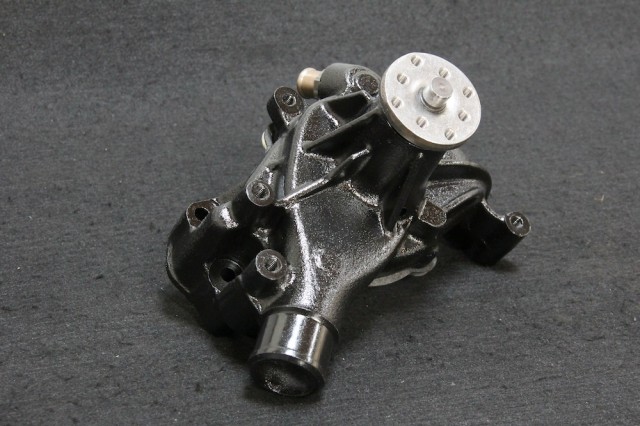 [8]
[8]Tuff Stuff’s improved steel water impeller helps small-block Chevy engines run approximately 30-percent cooler.
Water Pump
If you think the options for Gen 1 small-block Chevy water pumps are simply a matter of choosing between long-style and short-style, then you obviously haven’t seen all the Tuff Stuff offerings. From aluminum to cast-iron pump housings to 3/4-inch or 5/8-inch pilots in long or short style pumps.
Stasko clued us in on the primary feature that makes their water pumps a true upgraded component. “Our SBC water pumps have custom water impellers that are an all-steel fabricated piece. With the improved flow and surface area, these pumps run about 30% cooler which is about 20-degrees drop in temperature.”
Available in chrome plated, polished, powdercoated colors, platinum or “as cast” finishes.
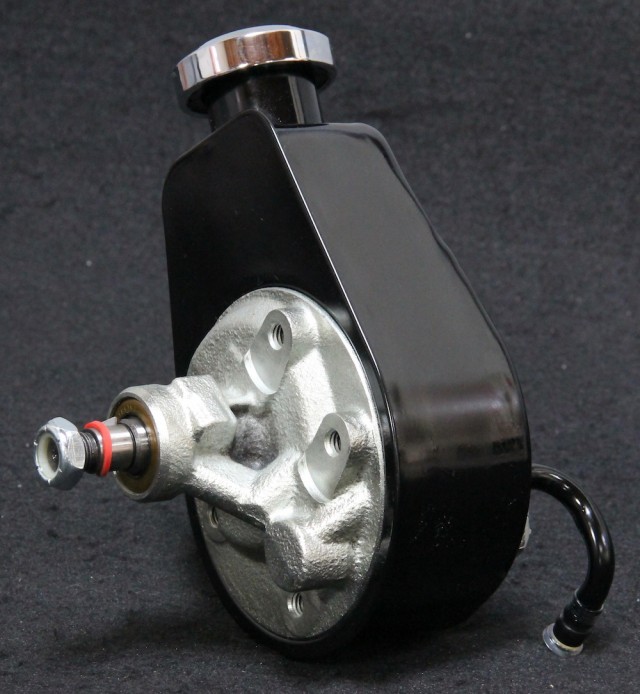 [9]
[9]Tuff Stuff’s Saginaw-style power steering pump is a direct GM stock replacement but made completely from new components at the Tuff Stuff facility.
Power Steering Pump
For GM applications, Tuff Stuff makes both Saginaw and Type II power steering pumps. The Saginaw-style pumps feature a billet-style cap with integral dipstick in chrome or cool black powdercoat to match your other accessories. The Type II power steering pumps are available in either OE ports or AN fittings depending on the needs of the application.
“All components are new and not remanufactured,” says Stasko, “Including the reservoir and pump assembly. The 1,200 psi pumps work with most gearbox systems and the 850 psi pumps work with most rack and pinion steering systems.”
For our hard working utility coupe, we opted to go with the standard style Saginaw pump. The Type II pumps work extremely well for large engines in small engine bays – which was not going to be an issue on our project car.
Installation
Because we were replacing components that involved the charging system, cooling system and power steering we took the necessary precaution of disconnecting the battery, draining the cooling system and the power steering fluid.
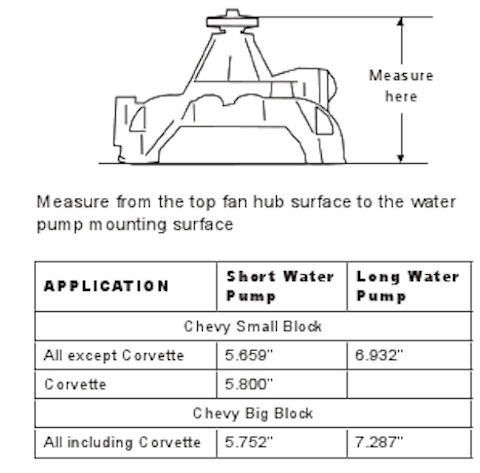 [10]The old alternator, water pump and power steering pump came out in a matter of minutes with three pairs of arms in the engine bay. Keeping dirt and grime away from the water passages and power steering lines is essential. This is where plastic parts bags and hose caps really come in handy.
[10]The old alternator, water pump and power steering pump came out in a matter of minutes with three pairs of arms in the engine bay. Keeping dirt and grime away from the water passages and power steering lines is essential. This is where plastic parts bags and hose caps really come in handy.
Needless to say, this is the perfect time to inspect the upper and lower radiator hoses for dry rot, cracking or worn spots from occasional rubbing on rotating components. A good check of the fan, fan clutch and pulley should be included in your inspection. An out-of-balance or defective fan, fan clutch or pulley will cause premature pump failure.
We also checked the V-belts for serviceability and verified that the new components were the same dimensions as the new replacement ones. This can be a show stopper if the water pump coming off is a short style pump and the new one is a long style.
After inspecting all the components, especially the ones you plan on re-using, cleaning the water pump mounting surfaces on the engine block will help assure a complete seal.
Years of Experience
There are certain things you pick up after years of experience and in our case, never take anything for granted. No matter how great the company and the products are, always check the obvious. With water pumps, any engine driven water pump, the fasteners on the back plate that cover the impeller should be checked. Even if it’s just to verify proper torque, check the fasteners for tightness.
Installation of the water pump is straight forward and simplistic if you follow the common practice of evenly tightening the bolts in a criss-cross pattern.
With the mating surfaces prepped and the impeller cover fasteners checked, the pump can be installed using new gaskets and sealer. Coat both sides of the gaskets and the mating surfaces with sealer. To ensure that the water pump is correctly installed with the sealer evenly distributed on the mating surfaces, tighten the mounting bolts gradually and evenly in a criss-cross pattern to factory torque specifications. In the case of our small-block Chevy, we torqued the bolts between 25 to 30 lb/ft of torque.
Installation of the fan and pulley is straight forward. Tighten the retaining bolts down securely and check for the bolt ends rubbing against the pump housing by rotating the fan by hand. On occasion the fan/pulley bolts are just long enough to scrape the pump housing. If this condition exists, a 1/16-inch shim can be purchased at your local parts store that solves the problem. Installing the shim between the water pump hub and the pulley will offer the clearance needed to prevent scraping.
Power Steering Pump Installation
“Our Saginaw style power steering pump is a direct stock replacement pump,” says Stasko. Installing the power steering pump is the direct reverse of the disassembly procedure, so there are no surprises here. Many of the Tuff Stuff power steering pumps do not come with a pulley which leaves several options available. We highly suggest purchasing Tuff Stuff’s billet cover to complete the engine’s look.
Installing the power steering pump is a snap because of Tuff Stuff's precision manufacturing of the assembly, making it a direct stock-type replacement.
Being a direct stock replacement pump, there is little to worry about as far as belt alignment is concerned. The Tuff Stuff black powdercoated GM power steering pump for 1970-1974 El Camino (Part #6183B) that we ordered fit perfectly to the front of our SBC 350.
Finishing the Install
Much like Tuff Stuff’s Saginaw-style power steering pump, their GM alternators mount to the engine block as easily as a stock replacement part. With all of the dimensions perfectly manufactured at the Tuff Stuff facility, mounting holes line up better than the OE components in most cases. This practically guarantees the same, if not better, drive belt alignment as you started with. In our case, it was a dead on perfect match.
The Tuff Stuff one-wire alternator installation is simplified because of the one wire and one ground electrical connections.
We rotated the pulleys to ensure clearance and free movement, connected the water hoses to the water pump and filled the cooling system and power steering pump reservoir with fluids.
After a quick start up to check for coolant leaks and cycling the power steering from lock to lock several times, there was little else to do but stand back and admire our new accessories.
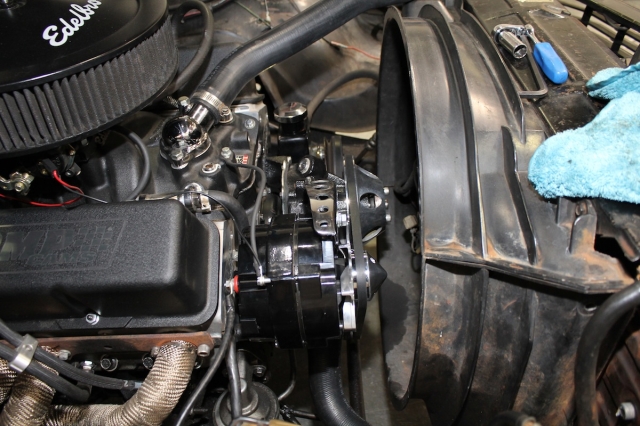 [19]
[19]Our Tuff Stuff engine accessory drive kit matched well with the rest of the crate engine components and made this real world daily driver a lot more stout and reliable.
